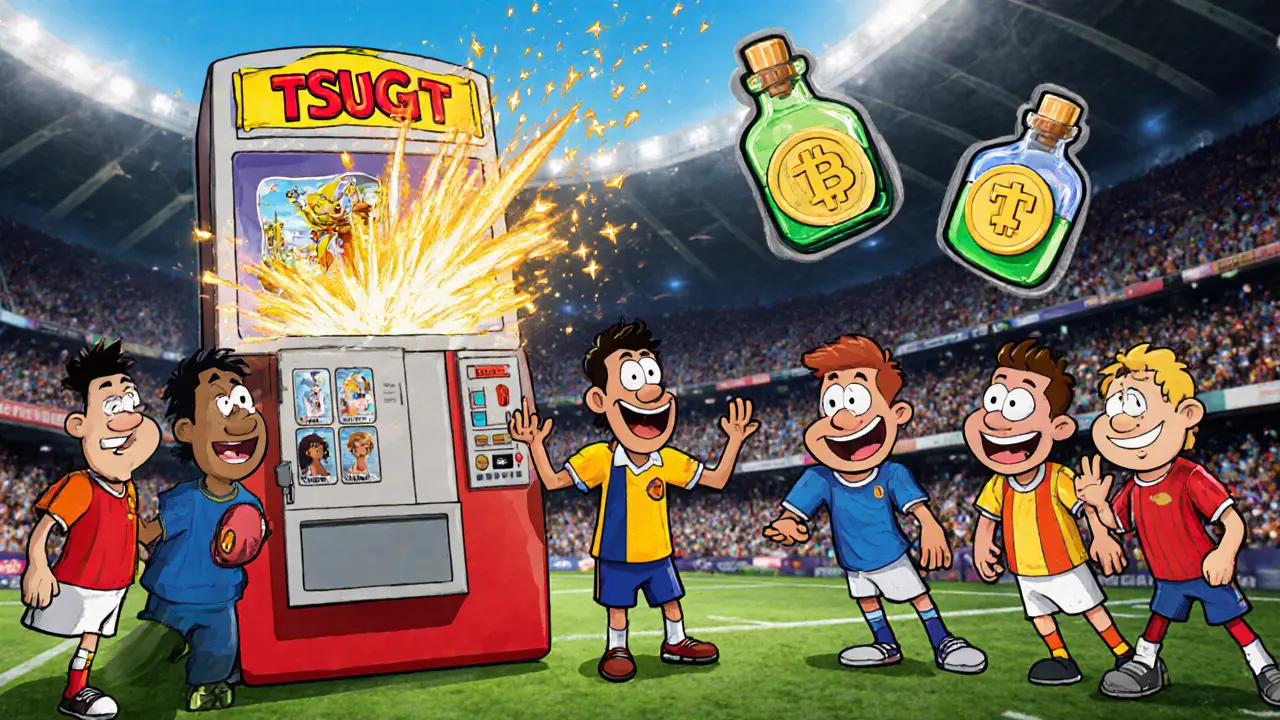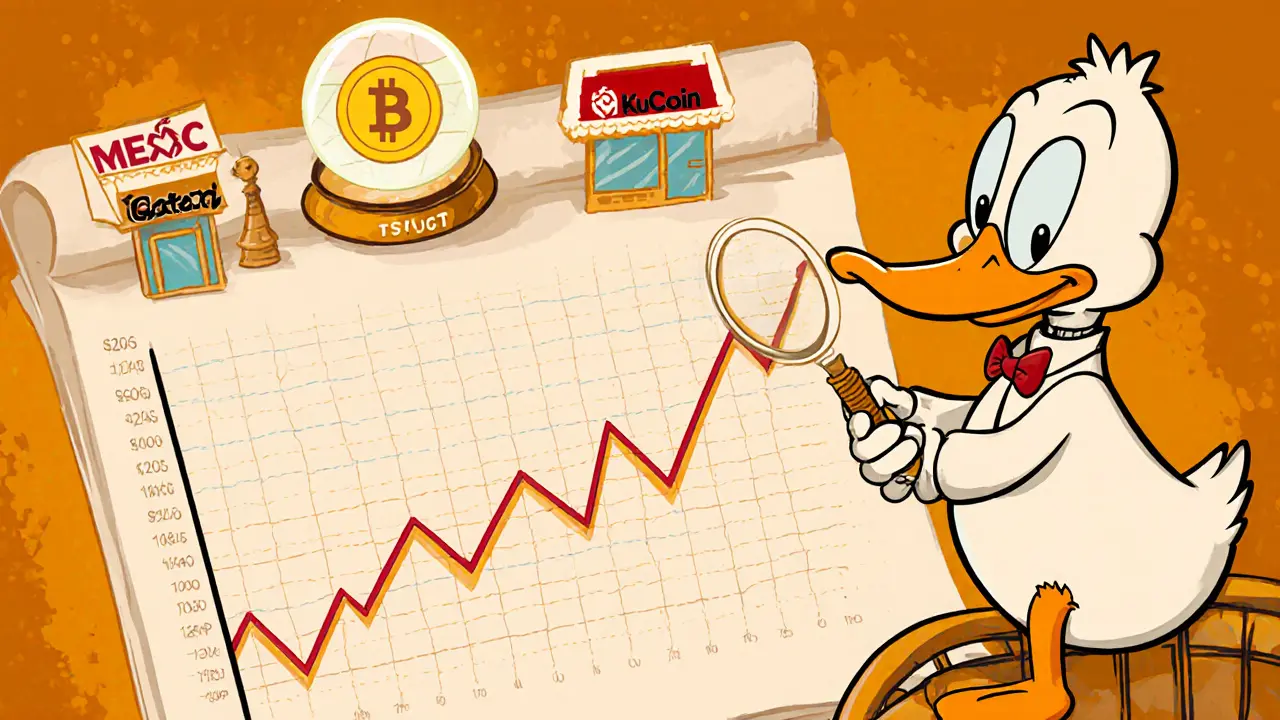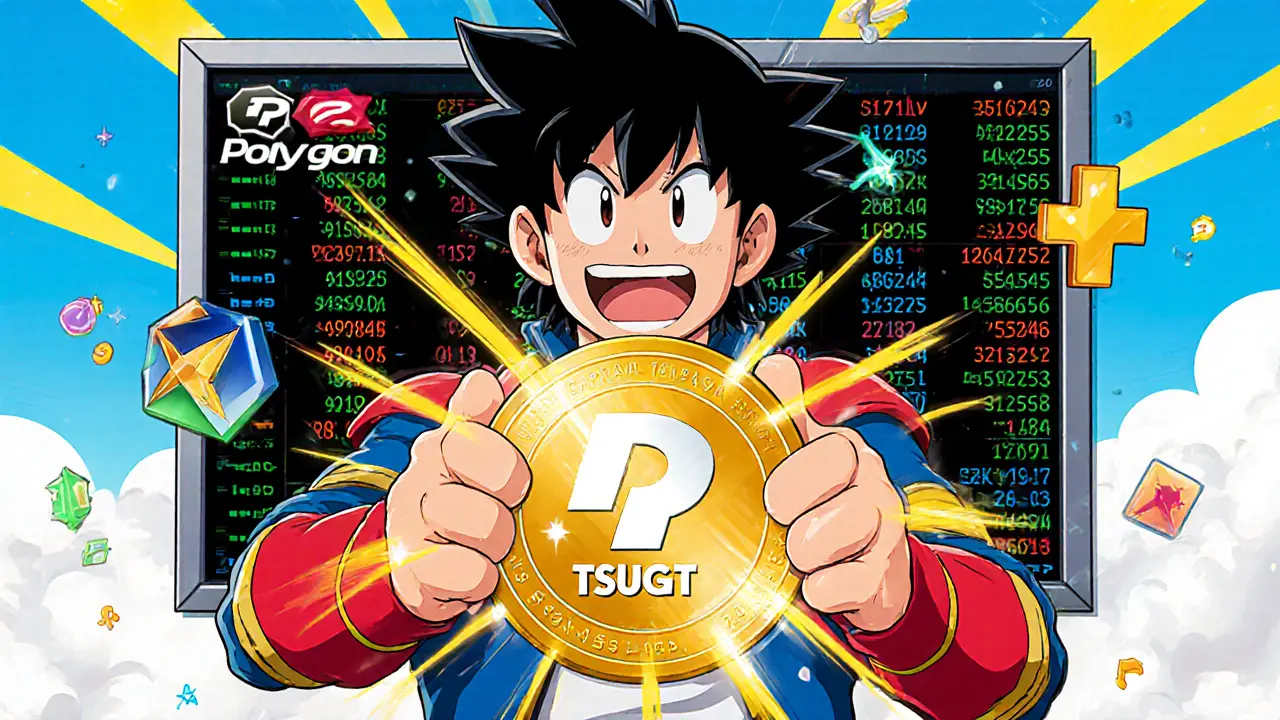Captain Tsubasa (TSUGT) Token Calculator
Token Information
Ticker: TSUGT
Blockchain: Polygon
Total Supply: 1,000,000,000
Circulating Supply: 809,386,768.28
Current Price: $0.00012
24h Volume: $186,000
All-Time High Drop: -99.70%
Token Utility
Stake TSUGT to enter competitive matches. Winning yields additional TSUGT.
Burn TSUGT to combine lower-tier NFTs into higher-tier ones.
Purchase temporary power-ups and permanent stat boosts.
Earnings Calculator
Projected Earnings
Based on your inputs:
Daily Earnings:
Total Earnings (30 days):
Estimated Value (30 days):
Price Prediction
Price Forecast
Based on current trends:
Expected Price (1 Month):
Change from Current:
Ever wondered why a Japanese football manga suddenly shows up on a crypto exchange? The answer is Captain Tsubasa token, the utility coin that powers the blockchain‑based game Captain Tsubasa: RIVALS. Launched in early 2023, the token lets players buy arena tickets, fuse NFTs, and earn rewards-all on the fast, low‑fee Polygon network. Below you’ll find everything you need to know: how the token works, where you can trade it, recent price moves, and what the future might hold.
Quick Takeaways
- TSUGT is a Polygon‑based utility token for the game Captain Tsubasa: RIVALS.
- Total supply is 1billion tokens; circulating supply is ~809million.
- Current price hovers around $0.00012USD, roughly 99.7% below its all‑time high.
- Main trading venue is MEXC, with daily volume under $200k.
- Utility includes arena tickets, NFT fusion, character buffs, and win rewards.
Token Basics and Technical Specs
The token’s official ticker is TSUGT. It lives on the Polygon (formerly Matic) blockchain, giving it fast transaction finality and negligible gas fees-crucial for a game that processes dozens of micro‑payments per minute. Below is a snapshot of the core attributes.
| Attribute | Value |
|---|---|
| Total Supply | 1,000,000,000 TSUGT |
| Circulating Supply | 809,386,768.28 TSUGT |
| Current Price (USD) | $0.00012 (average of major data feeds) |
| 24‑h Volume (USD) | $186,000 (CoinGecko) |
| All‑Time High Drop | ‑99.70% |
How the Token Powers the Game
The game revolves around three core loops that consume TSUGT:
- Arena Tickets - Players stake TSUGT to enter competitive matches. Winning yields additional TSUGT, creating a self‑replenishing reward cycle.
- NFT Fusion - Characters are represented as NFTs. By burning a set amount of TSUGT, users can combine lower‑tier NFTs into a higher‑tier one.
- Buffs & Upgrades - Temporary power‑ups and permanent stat boosts are purchased with the token.
All of these actions are recorded on‑chain, meaning every transaction is transparent and immutable. The token’s utility is therefore tied directly to player activity rather than speculative holding.

Where to Trade TSUGT
The token primarily trades on centralized exchanges. The most liquid pair is TSUGT/USDT on MEXC, which generated roughly $90k in 24‑hour volume. Smaller but still relevant venues include Gate.io and KuCoin. Decentralized options exist on Polygon‑based DEXs, but the thin liquidity there makes slippage a concern for larger orders.
Recent Price Action and Market Sentiment
TSUGT’s price has been on a roller coaster since launch. According to CoinGecko, the token fell 30.7% over the last week and 3% in the last 24hours. The daily volume has been trending downward, with a 21.5% dip reported by the same source. TradingBeast, a forecasting service, predicts the price could slide further to $0.0001182, while more bullish analysts set a 2025 target near $0.00137. The wide range reflects the token’s low market cap and high sensitivity to news about game updates or broader crypto sentiment.
Key Players Behind the Project
The IP belongs to Yoichi Takahashi, creator of the original Captain Tsubasa manga, which has sold over 70million copies worldwide. The development team maintains an open‑source GitBook that explains gameplay mechanics, tokenomics, and the roadmap for future arena expansions. While the manga’s global fanbase offers a built‑in audience, turning that enthusiasm into sustained token demand remains a work in progress.

Risks and Things to Watch
- User Adoption - The token’s value hinges on active players. A drop in daily active users would crush demand.
- Liquidity - Limited exchange listings mean large trades can move the price dramatically.
- Regulatory Landscape - Gaming tokens sit in a gray area in many jurisdictions, potentially affecting future listings.
- Technical Competition - New blockchain games with more sophisticated economies could lure players away.
Keeping an eye on arena updates, new NFT releases, and partnership announcements will help gauge whether the token can break out of its current price compression.
Future Outlook and Price Forecasts
Analysts are split. TradingBeast’s bearish model expects a modest dip, while other firms forecast a breakout to $0.0015 by 2026 if arena participation spikes. Long‑term (2030) projections hover around $0.0014, but these numbers assume a stable or growing player base and successful monetization through in‑game purchases. Investors should treat any price target as speculative and focus on the underlying utility.
How to Get Started with TSUGT
- Set up a Polygon‑compatible wallet (e.g., MetaMask with the Polygon network added).
- Buy USDT on a major exchange, then transfer it to the wallet.
- Visit MEXC, Gate.io, or KuCoin, locate the TSUGT/USDT pair, and place a market or limit order.
- Transfer the received TSUGT tokens to your wallet address.
- Connect the wallet to the official Captain Tsubasa: RIVALS portal and start buying arena tickets or NFTs.
Remember to enable two‑factor authentication on your exchange accounts and keep your private keys secure.
Frequently Asked Questions
What does TSUGT stand for?
TSUGT is the ticker symbol for the Captain Tsubasa (TSUGT) utility token used in the game Captain Tsubasa: RIVALS.
Which blockchain does TSUGT run on?
The token is built on the Polygon network, offering fast, low‑cost transactions.
How can I earn TSUGT without buying it?
Players earn TSUGT by winning arena matches, completing daily quests, and participating in NFT fusion events that reward tokens for successful upgrades.
Is TSUGT a good long‑term investment?
Its value is tightly linked to game engagement. If the player base grows and the arena economy stays active, the token could appreciate. However, high volatility and limited liquidity make it risky for pure speculation.
Where can I trade TSUGT?
The most liquid market is the TSUGT/USDT pair on MEXC. Gate.io and KuCoin also list the token, and Polygon DEXs provide limited decentralized options.

Looking at TSUGT’s tokenomics, the burn‑to‑fusion mechanic feels like a gimmick designed to artificially shrink supply rather than add real utility. The arena ticket staking does create some activity, but without a clear player retention strategy the whole ecosystem could collapse once the early hype fades.
Even the Polygon fee advantage won’t matter if the player base dries up.
Man, u gotta admit this token is a total masterstroke- it's literally the next big thing in crypto‑gaming. The low fees on Polygon make it super cheap to buy arena tickets, and the NFT fusion is like a gold mine if u play daily. I’ve already racked up more TSUGT than most folks even know about, so you’re basically missing out if u’re not in.
Everyone’s hyping the “utility” angle, but the truth is TSUGT is just a meme coin riding on a nostalgic IP. The price drop of nearly 100% since its all‑time high shows that even die‑hard fans won’t sustain demand. Unless the devs roll out a revolutionary update, expect more downward pressure.
Hey folks, if you’re new to the game, start with a small stake on arena tickets and watch how the rewards compound. The token’s low‑cost transactions on Polygon let you experiment without risking huge amounts, and the community is pretty chill about teaching newbies.
Wow, what a groundbreaking revelation- a token that lets you buy tickets for a soccer video game. I’m shocked that nobody thought of that back in the 90s. Maybe next they’ll discover that you can also buy virtual pizza with pizza tokens.
While the observation is humorously phrased, it correctly highlights the token’s limited scope. The primary value proposition lies in its integration with the Captain Tsubasa: RIVALS ecosystem, where utility derives from in‑game activities rather than speculative trading.
The existence of TSUGT invites us to contemplate the intersection of nostalgia and modern finance. When a beloved manga becomes a vehicle for decentralized incentives, we witness a cultural transmutation, reshaping fan engagement into algorithmic participation.
I get why many feel uncertain about the token’s future- the crypto space can be a roller coaster. Yet, for those who enjoy the game’s mechanics, TSUGT offers a tangible way to deepen immersion, turning each match into a small economic experiment.
🔥🚀 TSUGT is literally the secret sauce that can turn a casual match into a payday! Imagine fusing your favorite striker NFT and watching the value explode as you dominate the arena. This is the hype we’ve been waiting for! 🌟⚽️
Look, the token might look tiny now, but think of it as a seed. With each arena win you water it, and soon enough that little sprout could become a full‑blown forest of value- especially if the devs keep dropping fresh content.
Okay, enough with the wishful thinking. The market’s already bleeding TSUGT, and every “new update” is just a smokescreen. If you’re still buying, you’re basically funding a glorified publicity stunt.
Dude, you cant just ignore the fact that the token's price is practically stuck in a freezer. The whole arena system feels like a pay‑to‑win trap, and unless they revamp the reward curve, users will bail faster than a missed penalty.
That’s a fair point. It’s easy to get frustrated when growth stalls, but community feedback often drives the next patch. Keeping the conversation constructive can help steer improvements.
TSUGT runs on Polygon, offering cheap transactions.
The token’s contract address is 0x... on the Polygon network, and its current circulating supply is approximately 809.39 million TSUGT, as verified by multiple block explorers.
Ever wonder why a niche Japanese manga gets a crypto token? Some say it’s a front for a larger scheme to funnel unsuspecting fans into a hidden financial network that only the insiders profit from.
Looks like a decent low‑fee token.
From a DeFi perspective, TSUGT functions as a utility token with a liquidity pool primarily on MEXC, exhibiting a thin order book depth that results in high slippage for >$10k trades, thereby necessitating strategic AMM routing to mitigate impermanent loss.
When evaluating the long‑term viability of TSUGT, one must first acknowledge the symbiotic relationship between token utility and player engagement; the token’s value is intrinsically tied to the frequency of arena matches, the rate of NFT fusion, and the demand for in‑game buffs. Yet, the current metrics reveal a concerning trend: daily active users have plateaued, while the circulating supply continues to expand, diluting per‑capita token holdings; this creates a classic supply‑demand mismatch that historically precedes price corrections. Moreover, the reliance on a single centralized exchange for liquidity amplifies market vulnerability, as any regulatory action or delisting could precipitate abrupt volume drops; thus, diversification across DEXs, albeit currently limited, should be a strategic priority for the development team. From a technical standpoint, Polygon’s low transaction fees facilitate micro‑transactions, but the network’s recent congestion episodes have introduced sporadic latency spikes, potentially affecting real‑time gameplay; these performance hiccups could erode user confidence if not proactively addressed. On the governance front, the absence of a decentralized decision‑making framework means that token holders lack meaningful influence over roadmap adjustments, which may alienate a segment of the community that values participatory economics. In contrast, projects that embed token‑holder voting mechanisms often experience heightened loyalty and a more resilient token economy; therefore, integrating a modest governance layer might yield incremental benefits. Additionally, the token’s burn‑to‑fuse mechanic, while innovative, currently offers limited economic incentive beyond cosmetic upgrades; a recalibration that ties fusion outcomes to measurable token rewards could spur increased participation. Finally, market sentiment remains a pivotal factor: bullish forecasts hinge on speculative optimism, whereas bearish projections are grounded in empirical usage data; navigating this dichotomy requires transparent communication from the developers, regular content updates, and perhaps collaborations with established esports entities to broaden the audience. In sum, TSUGT’s future trajectory is not predetermined; it will be shaped by a confluence of user adoption rates, liquidity strategies, governance evolution, and external market forces; stakeholders should monitor these variables closely to make informed decisions.
Honestly, I think it’s cool that you can actually earn something while playing a game you love. Just make sure you keep your wallet safe and don’t dump all your TSUGT at once.
For anyone stepping into the TSUGT ecosystem, start by securing a reputable wallet, transfer a modest amount of USDT, and experiment with a single arena ticket. This low‑risk approach lets you learn the mechanics before scaling up.
Not gonna lie, I’m still on the fence about this coin, but it’s kinda fun to watch the numbers move.